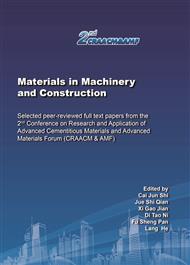[1]
S. Iijima, Helical microtubules of graphitic carbon, Nature. 1991, 354:56.
Google Scholar
[2]
F.V. Ferreira, W. Franceschi, B.R.C. Menezes, et al, Chapter One - Synthesis, Characterization, and Applications of Carbon Nanotubes, Carbon-Based Nanofillers Their Rubber Nanocompos.. 2019: 1-45.
DOI: 10.1016/b978-0-12-813248-7.00001-8
Google Scholar
[3]
J. Kong, H.T. Soh, A.M. Cassell, C.F. Quate, et al, Synthesis of individual single-walled carbon nanotubes on patterned silicon wafers, Nature.1998, 395(6705): 878-881.
DOI: 10.1038/27632
Google Scholar
[4]
A. Thess, R. Lee, P. Nikolaev, et al, Crystalline ropes of metallic carbon nanotubes, Science. 1996, 273(5274): 483-487.
DOI: 10.1126/science.273.5274.483
Google Scholar
[5]
X. Zhao, M. Ohkohchi, M. Wang, et al, Preparation of high-grade carbon nanotubes by hydrogen arc discharge, Carbon. 1997, 35(6): 775-781.
DOI: 10.1016/s0008-6223(97)00033-x
Google Scholar
[6]
L.M. Esteves, H.A. Oliveira, F.B. Passos, Carbon nanotubes as catalyst support in chemical vapor deposition reaction: A review, J. Ind. Eng. Chem. 2018(65): 1-12.
DOI: 10.1016/j.jiec.2018.04.012
Google Scholar
[7]
P.L. Suryawanshi, S.P. Gumfekar, B.A. Bhanvase, et al, A review on microreactors: Reactor fabrication, design, and cutting-edge applications, Chem. Eng. Sci. 2018(189): 431-448.
DOI: 10.1016/j.ces.2018.03.026
Google Scholar
[8]
A. Sumanth, S. Shirish, A. Bharat, et al, Process intensification of copper chromite (CuCr2O4) nanoparticle production using continuous flow microreactor, Chem. Eng. Process. 2015(89): 28-34.
DOI: 10.1016/j.cep.2014.12.012
Google Scholar
[9]
H.B. Yu, M.D. Wang, J.H. Zhou, et al, Microreactor-assisted synthesis of α-alumina nanoparticles, Ceram. Int. 2020(46): 13272-13281.
DOI: 10.1016/j.ceramint.2020.02.105
Google Scholar
[10]
Q.A. Wang, J.X. Wang, M. Li, et al, Large-scale preparation of barium sulphate nanoparticles in a high-throughput tube-in-tube microchannel reactor, Chem. Eng. J. 2009(149): 473-478.
DOI: 10.1016/j.cej.2009.02.018
Google Scholar
[11]
Q. Gao, Y.N. Wang, Y.F. Pan, et al, NF3 decomposition over V2O5, Fe2O3 and Co3O4 coated-Al2O3 reagents: the effect of promoter loadings on reactivity, J. Environ. Chem. Eng. 2020(8): 103890.
DOI: 10.1016/j.jece.2020.103890
Google Scholar
[12]
K.S.W. Sing, Reporting physisorption data for gas/solid systems with special reference to the determination of surface area and porosity (Recommendations 1984), Pure Appl. Chem. 2013(57): 603-619.
DOI: 10.1351/pac198557040603
Google Scholar
[13]
S.B. Sinnott, R. Andrews, D. Qian, et al. Model of cabon nanotube growth through chemical vapor deposition. Chem. Phys. Lett., 1999, 315(1-2): 25-30.
DOI: 10.1016/s0009-2614(99)01216-6
Google Scholar
[14]
S.X. Sun, J.Q. Hu, J. Li, et al, Effect of calcination temperature on synthesis of carbon nanotubes CO2 chemical vapor deposition catalyzed by Ni-Fe catalyst, Mod Chem Ind. 38 (2018) 168-172.
Google Scholar
[15]
V.I. Alexiadis, N. Boukos, X.E. Verykios, Influence of the composition of Fe2O3/Al2O3 catalysts on the rate of production and quality of carbon nanotubes, Mater. Chem. Phys. 2011,128(1-2): 96-108.
DOI: 10.1016/j.matchemphys.2011.02.075
Google Scholar
[16]
X. Jiang, X.C. Chen, C. Ling, et al, High-performance Cu/ZnO catalysts prepared using a three-channel microreactor, Appl. Catal., A. 570 (2019) 192-199.
DOI: 10.1016/j.apcata.2018.11.023
Google Scholar


